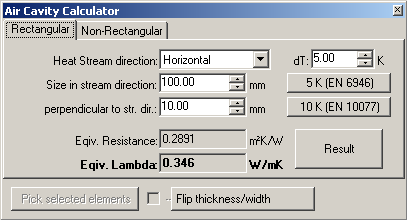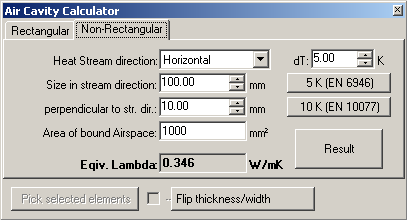Air Cavity Calculator (Tool)
 The
Air Cavity Calculator window is used as a tool for rapid calculation of
equivalent heat conductivity of small air cavities and air gaps based on the
input of their dimensions and heat stream direction.
The
Air Cavity Calculator window is used as a tool for rapid calculation of
equivalent heat conductivity of small air cavities and air gaps based on the
input of their dimensions and heat stream direction.
To calculate equivalent heat conductivity (lambda) the application uses formulas
defining calculation of heat transfer resistance of air spaces described in EN ISO
6946:2005 Appendix B - please be aware of limitations related to its application (e.g.
small, closed air cavities).
Calculation regulation are geared to European norms
EN ISO 6946 and EN ISO 10077-2 and cover two dimensional calculations.
This tool can be started from the menu Tools.
| Heat Stream direction | Definition of heat stream direction:
|
| Size in stream direction | The size of the cavity measured in the heat stream
direction (thickness). Remark: Thickness and width can be swapped via a context menu. |
| perpendicular to str. dir. | The size of the cavity perpendicular to the stream
direction (width) Remark: Thickness and width can be swapped via a context menu. |
| Temperature difference dT | The difference of temperature between cavity boundaries in
the heat stream direction. Remark: According to normative regulations one shall set the temperature difference, if exact value is not known, accordingly. Buttons "5K (EN 6946)" and "10K (EN 10077) set this value to one of magnitudes required in these respective regulations. |
| Equiv. Resistance | Equivalent heat transfer resistance of particular air cavity |
| Equiv. Lambda | Equivalent heat conductivity of particular air cavity |
| Result | Calculation result is replaced by the actual value. A double click on this button results in an assignment of the calculation result to currently selected elements of element list. Remark: The button is also used a a source of a drag-drop operation of material property of a equivalent material. |
Remark: An air cavity will consist of only one element rarely; usually an air cavity is described by a group of several elements.
 For
the very usual case of non rectangular air cavities normative regulations
define following procedure to account for:
For
the very usual case of non rectangular air cavities normative regulations
define following procedure to account for:
An equivalent conductivity is to be calculated for a fictive rectangular cavity. Such fictive cavity shall be constructed as follows:
- create a rectangle surrounding the cavity of interest.
- the area of a fictive cavity rectangle shall be equal to the area original (non rectangular) cavity.
- the ratio of width to the height of the fictive rectangle cavity shall be the same as of the rectangle surrounding the original.
The conductivity calculated for such fictive rectangular cavity is the used instead for the (non rectangular) original air cavity.
| Heat Stream direction | Definition of heat stream direction:
|
| Thickness (stream dir.) | The thickness of the rectangle surrounding the cavity measured in the heat stream
direction. Remark: Thickness and width can be swapped via a context menu. |
| Width | The width of the rectangle surrounding the cavity (perpendicular to the thickness) Remark: Thickness and width can be swapped via a context menu. |
| Area | The actual are of the real (non rectangular) air cavity |
| Temperature difference dT | The difference of temperature between cavity boundaries in the heat stream direction. |
| Equiv. Lambda | Equivalent heat conductivity of particular air cavity |
| Result | Calculation result is replaced by the actual value. A double click on this button results in an assignment of the calculation result to currently selected elements of element list. Remark: The button is also used a a source of a drag-drop operation of material property of a equivalent material. |
Remark: For this procedure the most sophisticated it is to calculate the real are of the non rectangular cavity itself.
Air cavity dimension picked from element selection
This air cavity calculator provides a feature allowing automatic acquisition
of area and dimension values from current
element selection.
Already selected temperature difference and stream direction are not affected.
Only dimensions of the rectangle surrounding selected element(s) and the sum of
its/their respective area(s) are automatically calculated and transferred into
calculator.
Possibly one will have to swap the thickness and width manually (via the context
menu or respective button) to adjust to the fact, that the thickness must be
specified parallel to the assumed stream direction!
Applying the result onto selected elements
A double click onto the button "Result" will apply the calculated
result of equivalent conductance onto all material elements currently selected
within the element list.
For the material's name a text "Cavity dir t=..w=..(A=...) dT=..."
is used.
Remark: The result (equivalent lambda) can be drag-dropped from the button "Result" directly onto am element within element editor or onto elements (Element list, Elements 2D) or event into material list.
As an alternative, to assign the result (an equivalent lambda),
on can use the clipboard also: Click onto the result field "Equiv. Lambda"
with the right mouse button and select "Copy". Then you are able to
paste the resulting value into the
lambda input field of the element
editor
or material editor within the
material list (by pasting it from the clipboard there).
Remark: The exact direction of stream flow is known in advance within multi dimensional calculations. This means, that the requirement to decide the correct choice of the "width" and "thickness" for the cavity cannot be fulfilled easily. It is user's decision to estimate the right heat stream direction by some heuristics based on his experience („along the x- or y-axis“).
Note: You shall switch between input fields by using the TAB-key. Using that key confirms the data entry. On the other hand it provides a good alternative compared to permanent mouse use.
Additional remarks
- The standalone version of the tool can be invoked with an argument of "en" or "de" to work in the language different from the operating system default.
See also: Element Editor, Materials window, Element selection window, Elements 2D window